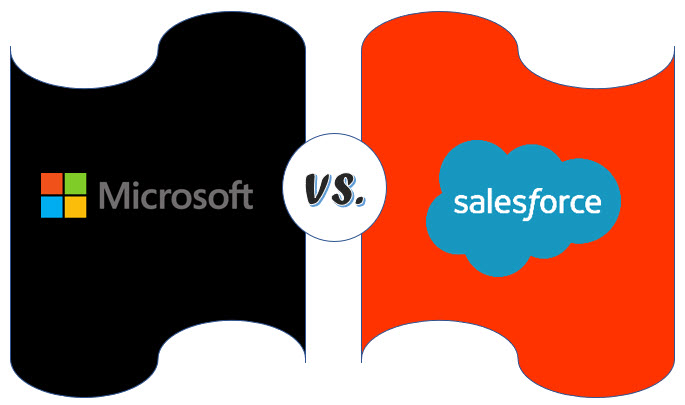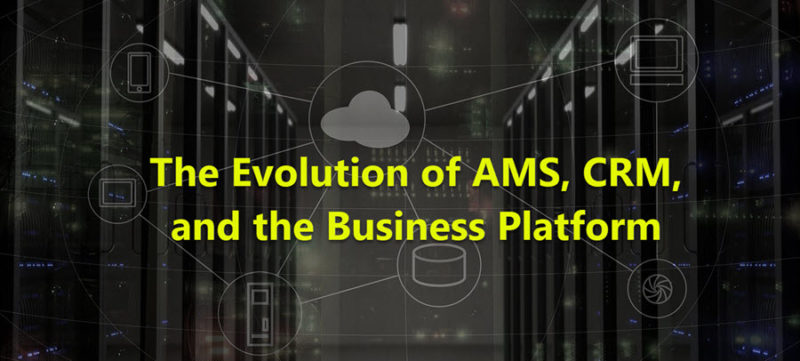Microsoft or Salesforce: What is the Best Platform for Your Association?

[vc_row][vc_column][vc_column_text]Within the Association landscape there are multiple AMS (association management software) solutions. That scope narrows significantly when looking at progressive software models that promote the idea of digital transformation. The two most robust and popular Business Platforms used by associations then comes down to Microsoft Dynamics and Salesforce, but which one is the best?[/vc_column_text][/vc_column][/vc_row][vc_row][vc_column][vc_empty_space][vc_column_text] Growth Comparison Statistics Since 2014, Microsoft has focused on its SaaS business, and business is great. They have grown from a $380B (market cap) to a greater than $800B company in just four years. Most of that growth is attributable to their Business Platform. Some of the more popular components of the platform include: Microsoft Azure Business Cloud – growing at a staggering 75% growth rate Artificial Intelligence (AI) – Microsoft AI and Research has 8,000+ employees working every day to make easy AI available to everyone. (No other company is doing more to make AI easier than Microsoft. No other company is investing more in AI than Microsoft.) Microsoft BOT Service – provides an integrated environment that enables you to build, connect, test, deploy, and manage intelligent bots – all from one place. This initiative alone has over 300,000 developers working with it to continually improve your experience. Microsoft makes many acquisitions each year, and over ¾ of them directly benefit the Dynamics business platform.[/vc_column_text][vc_empty_space height=”20px”][vc_column_text][supsystic-tables id=1][/vc_column_text][vc_empty_space height=”20px”][vc_column_text]Like Microsoft, Salesforce has also grown and is doing a fantastic job. It’s gone from a $60B (market cap) to a $155B company in just 4 years. They, too, have also acquired a few companies. Some of Salesforce’s notable acquisitions include: Heroku – In 2010 they added this platform as a service (PaaS) that enables developers to build, run, and operate applications entirely in the cloud. MuleSoft – In 2018, they added the most widely used integration platform for connecting SaaS & enterprise applications in the cloud and on-premise. Datorama – In 2018, Datorama joined the Salesforce community by bringing AI enhanced marketing to compete with the Azure based Adobe Marketing Cloud. Platform Summary: Microsoft’s platform is the fastest growing, has the greatest number of business apps and connectors, and is the largest platform available to organizations. Microsoft is accelerating debt free at a tremendous rate making it very difficult for other platforms to keep pace. Due to its rapid growth – platform connections, integrations, and offerings are always being updated and added. It is also the most affordable, has frequent price drops, and performance increases.[/vc_column_text][/vc_column][/vc_row][vc_row][vc_column][vc_empty_space][vc_column_text] Pricing Models Both Salesforce and Microsoft offer varying SaaS pricing models. While it is difficult to compare them exactly the same way, Microsoft is typically 2/3 the overall cost of ownership when looking at equivalent features. The key is to look deeper into initial set up costs, licensing, transactions costs, API costs, feature costs and ROI over the long term. Unlike Salesforce, “Upsell” and “Go Live” cost increases are not part of Microsoft’s plan. Microsoft is generous with licensing and does not halt you like others do if you dip into an unlicensed feature. Reflected in Dynamics’ price is its robust out of the box functionality and inherit Microsoft integration. When associations are quoted implementation costs of a Dynamics based platform, the costs may initially come in higher than Salesforce. The key is to look deeper at the long-term costs. The cost to add apps is significantly reduced with a Dynamics implementation because so many apps are already included. Salesforce does not have the same number of included apps with its application. While the extensibility of the platform is comparable to Microsoft’s, the cost of implementing the extended functionality will most likely be much higher. Salesforce offers basic services out of the box, and they have a sizable AppExchange that allows users to easily extend their platform. The apps there are all designed to integrate with the Salesforce platform. What you may not know is that the AppExchange typically adds 25% to the cost of the app. Also, you cannot bypass Salesforce’s AppExchange to purchase your necessary apps from another venue. Microsoft has 3 “App Stores” (CRM, Azure, Office) with some overlap and thousands of apps. Unlike Salesforce, there are many hundreds of other app stores that allow you to add apps without paying that commission. In fact, many of the apps in Microsoft’s app stores are free and open source. To help give you a better understanding of the platforms’ price differences, we have developed the following comparison chart:[/vc_column_text][vc_empty_space height=”20px”][vc_column_text][supsystic-tables id=2][/vc_column_text][/vc_column][/vc_row][vc_row][vc_column][vc_empty_space height=”20px”][vc_column_text]When viewing a demo in either platform you need to be sure the demo you see is the product you will ultimately get. For example, if the demo is showing you the Lighting Enterprise license but your users are getting a Force.com license that is like test driving a Mercedes S Class and then learning the car you bought was a Toyota Celica. Shameless plug: Altai demos using the team license, and when demoing to the sales team at your organization, we demo using the Customer engagement. Platform Cost Summary: Microsoft is considered by experts to be approximately 2/3 the overall cost of ownership versus Salesforce. That said it is recommended you do your research when considering licensing for each product. Beware of licenses that will need to be upgraded on “Go Live” day. When that day comes, it will be too late to shop and negotiate pricing.[/vc_column_text][/vc_column][/vc_row][vc_row][vc_column][vc_empty_space][/vc_column][/vc_row][vc_row][vc_column][vc_column_text] Microsoft vs. Salesforce by the Numbers Both Microsoft Dynamics and Salesforce provide equivalent sales, service, and marketing functionality. Both provide customization data entry form design, easy reporting, social monitoring, app stores, dash-boarding, etc. Companies like Altai have added your necessary features such as membership, events, certification, donation and member commerce to Microsoft Dynamics. To understand what each company is doing in terms of investments, hiring, and giving, review the chart below:[/vc_column_text][/vc_column][/vc_row][vc_row][vc_column][vc_column_text][supsystic-tables id=3][/vc_column_text][vc_empty_space height=”20px”][/vc_column][/vc_row][vc_row][vc_column][vc_column_text]Platform Summary: While Salesforce has grown significantly over the last five years, they can’t touch Microsoft in terms of resources. The financial and technical investments Microsoft makes in their own products and
The Evolution of AMS, CRM, and the Business Platform

[vc_row][vc_column][vc_column_text] In today’s association marketplace, most people in the industry understand the basic functions of an AMS (association management software) solution. At its core it is a database that houses membership, event, and basic accounting data. Starting in 2005, progressive associations started learning about what the Fortune 500 companies where doing with true CRM systems that Siebel and others were creating. Organizations wanted to have interconnectivity between their various software’s. They wanted one place where they could get a 360° view of their customers and access their marketing, finance, community, etc. data under one main umbrella. Thus, using CRM (customer resource management) solutions in associations began. Unlike AMS systems who try to retro-fit their software to plug holes created by new software integrations, CRMs were designed from their onset to seamlessly integrate and extend associations’ software capabilities. Top CRMs Used by Associations Today Today from a CRM perspective, the top two in the association marketplace are Microsoft Dynamics and Salesforce. Both CRMs provide equivalent sales, service, and marketing functionality. They also both provide customizable data entry form design, easy reporting, social monitoring, app stores, dashboarding, etc. Companies like Altai have added membership, events, certification, donation and member commerce to CRM. Historically, Salesforce was first out with a CRM SaaS solution, and today they have 19% of the market. Since then others have also introduced SaaS models and have captured the rest of the market: Microsoft has 5%, Oracle, SAP, Sugar, HubSpot, Zoho and others have 75% of the market combined. What is a Business Platform? As technology continues its constant evolution, so too must associations continue to evolve in their approach association management. Today’s progressive organizations need more than just a CRM. They need security from hacking. They need Business Intelligence (BI) to collect, integrate, and analyze complex data. They need global compliance (GDPR, and many others). They need artificial intelligence (AI) to help anticipate their members’ needs. They need multi-channel marketing automation to reach members on every communication platform they are currently using. They need financial management (ERP) for forecasting. Simply put – they need MORE. Business platforms provide organizations all the same things traditional CRM platforms provide and MORE. They provide, security, BI, AI, ERP, temporary and permanent infrastructures, service management, sales management, identity management, community management, integration management, data quality management, countless extendable apps, etc. The list goes on and on! Arguably the most robust Business Platform is Microsoft Dynamics. Top Platform Facts Approximately one-third (1/3) of organizations worldwide are currently using Office 365. Chances are very high that your organization is using Office 365 right now. If you are, you should know that NO OTHER Business Platform can integrate as seamlessly with Office 365 as Microsoft Dynamics. They are made to go together. Dynamics even appears as an “app” on the Office 365 dashboard. How Do I Know if I Need a Platform? If you are contemplating a digital transformation change, then you need a platform. If you are constantly adding and integrating systems to support ever-growing needs to support your members, then you need a platform. If you have an IT staff that wants to be relevant to today’s marketplace, then you need a platform. If you believe that your needs are beyond supporting simple revenue streams, then you need a platform. If your organization operates more like a current Fortune 500 corporation instead of the typical association business model formed in late 80s and early 90s, then you need a platform. Do you derive all your revenue from membership, events, products, a few donations, etc.? Is your business model for the next 10 years projected to be the same as the last 20 years? Then you will be better served by sticking with your current legacy system or purchasing a new inexpensive AMS. If you answered, “No,” to these questions, then the time has come for you to evolve with the times, purchase a Business Platform and undergo a digital transformation. Contact us at sales@altaisystems.com to learn how we can show you what the power of the Microsoft Dynamics 365 platform, on which Altai Systems is built, can do for your organization.[/vc_column_text][/vc_column][/vc_row]
Altai Announces New Partner

[vc_row][vc_column][vc_column_text]We are expanding our leadership team as a part of Altai’s continued growth and commitment to innovation. Therefore, we are excited to announce that as of January 1, 2019, Altai’s newest partner is Grant Costello! Journey to Partner Grant started as a Consultant with Altai in 2010. As time progressed, Grant wrote more and more code and was tapped for his ideas on multiple projects. Last Spring, Altai’s current partners, Mike Frye and Jon Martin, approached Grant with an offer of a minority share in Altai Systems. Grant accepted, and the agreement was finalized last month, Goals for Altai’s Development Grant’s role is to lead the development team and oversee Altai’s custom features. In addition, he will lead the development of new features and oversee product architecture. When asked about his future goals at Altai, Grant replied, “I’m excited to be able to help shape the Altai product. I want to bring new features that make people’s jobs easier and automate maintenance and configuration so their time can be better spent with their members.” Personal Profile Grant is a Baltimore, Maryland native who attended the University of Maryland – Baltimore County (UMBC) majoring in Information Systems. While still in school, he worked full-time for another software company prior to starting at Altai. In addition to his interest in software development, he is also interested in the collection and storage of solar energy. He is a hobbyist who collects old laptop batteries with the goal of someday building his own power back system. Recently married, Grant resides in Baltimore with his new bride and 30 pound adopted rescue dog, Dixie. Congratulations, Grant! We can’t wait to see your plans in action.[/vc_column_text][/vc_column][/vc_row][vc_row][vc_column][vc_row_inner][vc_column_inner][vc_empty_space height=”20px”][/vc_column_inner][/vc_row_inner][vc_cta h2=”Experience Altai’s Unlimited Capabilities” txt_align=”center” style=”3d” color=”blue”]If you are interested in learning about Altai’s features, then sign up today for our next webinar: The Power of the Altai Systems Platform Built within Microsoft Dynamics.[/vc_cta][/vc_column][/vc_row]


